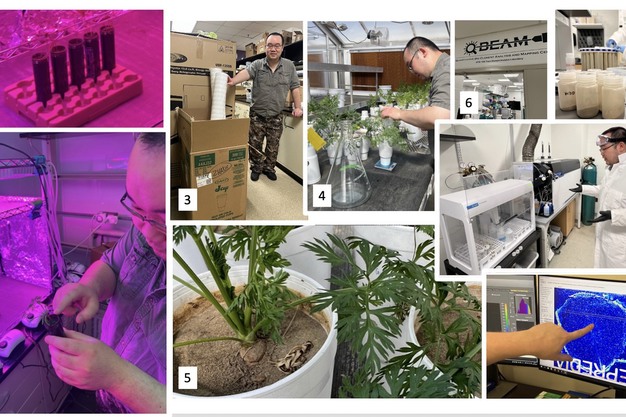Chenxi and team are growing carrots in soil sampled at a Michigan carrot farm to evaluate the uptake of metalloids at various growth stages, soil amendment application conditions, and soil moisture levels.

In this project, as introduced previously in MSU Today, under the supervision of faculty members, Chenxi and the team are growing carrots in soil sampled at a Michigan carrot farm to evaluate the uptake of metalloids at various growth stages, soil amendment application conditions, and soil moisture levels. The project involves experimenting with soil amendments and hydration regimes to reduce bioavailability and uptake of toxic metalloids (e.g., As, Cd, Cr, Pb etc.). It's an exciting prospect with the potential for implications in Michigan agriculture: the hypothesis is that different developmental and climatic conditions will be highly consequential.
Chenxi came to crop science from Beijing in 2014, and he finished his BSc degree in microbiology at MSU. He then completed his MSc in materials science, working with low-dimensional materials.
And now he's learning how to grow carrots. "I'm learning numerous new knowledge and skills in different disciplinaries, and I will combine them together to enhance the quality of crops" Chenxi said, including the nuances of working with live plants, and figuring out the best materials and methods to get the information he needs.
- Microcosm in the lab
- In the early growth stage, much of the carrot root is above the soil
- Choosing the right equipment for larger-scale microcosm
- The hydration regime in the greenhouse
- Mature carrots sink deeper into the soil, with fewer roots sticking out of the top
- At the QBEAM Center on the MSU campus
- Preparing soil samples for analysis
- The Triple Quadrupole Inductively Coupled Plasma Mass Spectrometer (right) detects most all elements at mg-to-ng levels per liter
- Spatially resolved analysis achieved by laser ablation in combination with ICP-MS detection by scanning a laser beam across a carrot slice. The outline of the carrot slice is highlighted by a concentration of metalloids.
"We started seedlings in an opaque 50 mL centrifuge tube with a small hole at the bottom. The microcosm experiment provides a methodology to select the amendments to reduce toxic metal(loid) concentration in carrot root without jeopardizing the uptake of essential metal(loid). The microcosm-based soil amendment evaluation method is available for most root vegetables because the shoots and roots will be differentiated when the plant is young and tiny. We can collect the sample of soils and plants in about 20 to 30 days after the seedling." Chenxi said.
However, growing carrot plants to the matured stage needed more space. "We decided to try these Styrofoam drinking cups because they have enough depth and width to allow the carrot to develop a long tap root in the pot experiment. Still, the top tends to dry faster than the bottom of the cup, even though the surface area of the top is limited," Chenxi said.
Chenxi, with supervision and support from Professor Wei Zhang, figured out two strategies that can reduce the toxic metal(loid)s in the edible parts of carrot roots:
- Reducing the bioavailability of metal(loid) in the soil
- Increasing the translocation of toxic metal(loid) from roots to shoots
This is different from most crops because most crops' seeds and fruits are edible.
Chenxi also learned that the carrot first develops with much of the root growing above the soil in microcosm experiments and pot experiments. The current pot experiments are revealing the effectiveness of mixed amendments and moisture control in reducing the toxic metal(loid). Meantime, the pot experiments can find the amendment that is enhancing the disease resistance while reducing the toxic metal(loid) concentration in carrots roots.
"And after a while, as the carrot matures, it sinks deeper into the soil. I didn't know that would happen. We also had to figure out how much amendment we can add without actually killing the plants," Chenxi said.
An unintended result that we are seeing is that the metalloids are concentrating in the carrot tops – which are discarded," Chenxi said. "We have observed this phenomenon in this experiment."
Chenxi Li presented the method at the Tri-Societies meeting last October
Source: msu.edu
